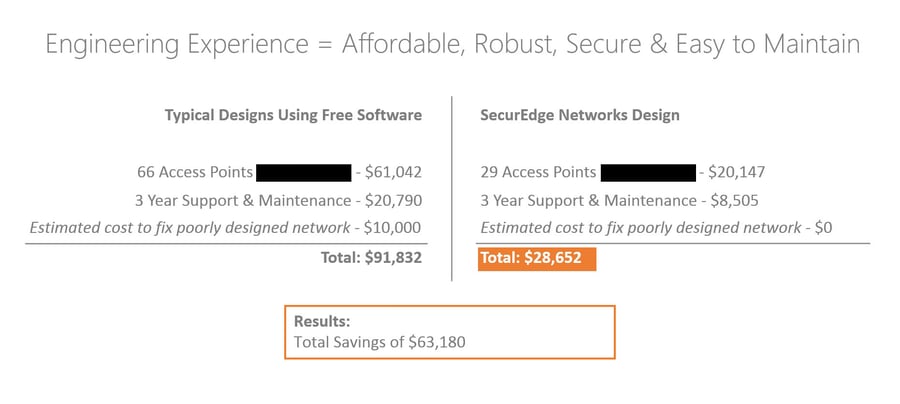
If you've made it to this point, you should reflect on two things: first, the days of your wireless network not being able to support your requirements are finally going to be resolved. Two, it's time to focus on the next part of the process and getting it done right the first time.
So where do you go from here? What does the process look like? Who should you choose to work with?
While the ideal process is unique to each situation,here's a breakdown of what should happen next.
First things First, Choosing the Right Wireless Service Provider
Figuring out that you need to upgrade your wireless network was a big moment, and one that didn't come easy, however, now it's time to not repeat past mistakes or make new ones and this means starting with choosing the right wireless service provider.
Your wireless service provider should be a trusted partner that leads the execution of the Wi-Fi engineering process from start to, well, never-ending (we'll explain more about that in a little bit).
Check out the quick 90 second video below to learn what questions you should ask any prospective provider.
If you'd like to find out even more about what you should look for check out this recent blog article for a more in-depth look.
The WiFi Engineering Process
Now that you've selected the right wireless service provider it's time to take the process to the fun part, designing your wireless network.
The process consists of 5 parts:
- Predictive RF Design
- Wireless Site Survey
- WLAN Engineering
- Performance Testing
- System Management
Starting with a predictive RF design, critical information is collected and run through specialized predictive design software.
This software is expensive and takes specific expertise to produce optimal results.
BEWARE! Not all designs are created equal. A lot of times inexperienced consultants or VARs will try to get away with using FREE design software usually supplied from the manufacturer and this can have terrible consequences on your wifi performance and your wallet.
Take a look at the example below. Here we have a comparison of one design created using Free software and another using specialized third-party software.
Pretty big-difference, huh.
Click on the image to view a high-res version
The one on the left has been over-engineered and will end-up not only costing the customer more up front but even more to correct the mistake after installation.
A predictive RF design takes into account the following:
- Building size (dimensions)
- Materials used to build the structure (the first two are where a blue print comes in handy)
- Devices being used
- Number of devices
- Types of Applications being used
- Potential RF Interference materials (metal mesh curtains for example)
Here's a quick whiteboard video from Senior Network Engineer, Michael McNamee on what you can expect to receive from a Predictive RF Design.
Step 2: Wireless Site Surveys
After your network engineer has successfully prepared your predictive RF design, they will ideally need to validate the design by doing and on-site wireless site survey.
Usually with schools and hotels (predictive RF designs have been found to be accurate within 5-10%), this isn’t as necessary as it is for businesses like Hospitals, or warehouse buildings.
Learn more about the different types of site surveys and assessments below:
The reason being some known environments are more complex to design for than others in our experience and require more on-site testing.
However, again every project is unique and requires the supervision of an experienced WLAN engineer to navigate the process accordingly.
Step 3: It's Engineering Time
Your WLAN design will include a list of the equipment necessary to deploy your network.
During the engineering phase the engineer should be able to do the following:
- Configuration of the security policies, access points, and the systems SSIDs
- Integration connection to the directory platform and network management software
- System testing proofing authentication methods and necessary security requirements
Step 4: Performance Testing
After all of these steps have been completed your network engineer should validate everything that has been put into place through coverage and capacity testing, as well as application performance testing.
It's critical that your wireless service provider validates that everything is working and functioning as it was designed and that it properly satisfies the requirements that were established at the beginning of the project.
Step 5: System Management
As we stated earlier in the blog, your new wireless system goes from start to "never-ending."
Here's what we mean.
You're new wireless system isn't set it and forget it. It's alive, and that means you have to constantly monitor it's health and operations on a daily basis to ensure optimal wifi performance.
Devices change, your physical environment can change, the number of users changes, and yes security threats change, you have to have a granular view when you need it as well as real-time data to make adjustments, quickly troubleshoot issues and even prevent them from happening.
So, once you've turned your new system on as you can see doesn't mean the process is over, in fact it's just getting started.
For more information on the importance of real-time visibility and usage analytics click here.
Final Thoughts
It can be a daunting task to refresh your wireless network, but with the right platform and the right partner it's easier than you think.
At the end of the day, you want to work with an experienced, certified wireless service provider, that you can partner with to create and manage the reliable, high-performing WLAN that you require.
If they can’t navigate as well as explain each step, like a doctor performing surgery, it's probably a good idea to say goodbye and move on to a company who is more capable!
At SecurEdge, we provide the platform to deliver an affordable, robust, and secure wireless system – it’s all we do. If you have any questions or would like to discuss an upcoming project, please contact us here.





